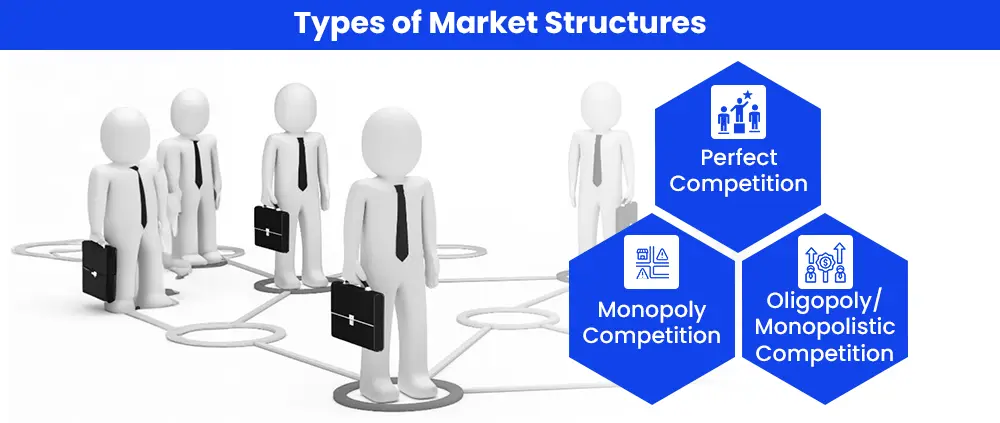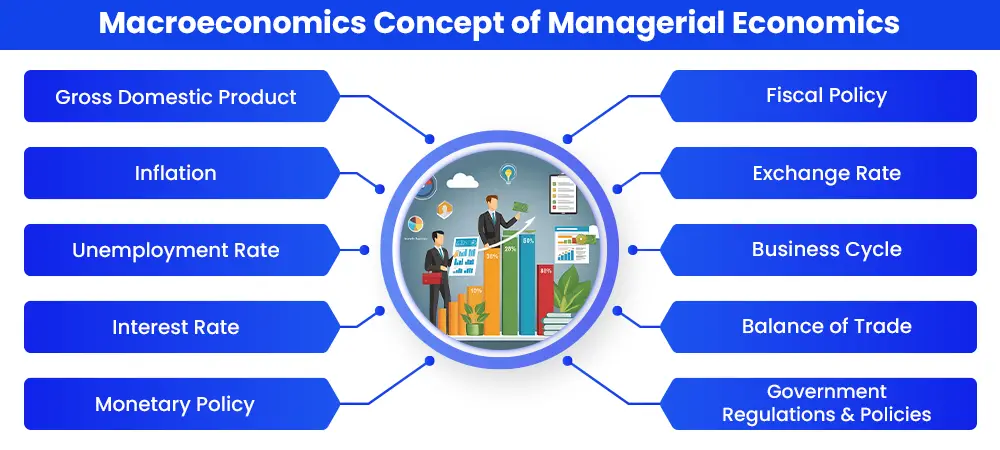Expert Interviews
- University Reviews
- Career Guide
 Video Counseling
Video CounselingImportant Facts
- Ask any Question - CV Forum

What is the role and scope of Managerial economics?
Isha Adhikari Sep 25, 2024 1.3K Reads

Managerial economics is the branch of economics that uses microeconomic analysis for specific business deals. It helps the superiors understand the economic principles and allows them to decide the tasks and allocate them among the employees as per their ability and field of expertise.
There is a wide variety of scopes of managerial economics, including microeconomic factors such as demand analysis, cost and production analysis, market structures, and pricing strategies. Along with that, it also includes macroeconomic factors such as national income determination, business cycles, monetary and fiscal policy, and international trade. It also includes econometrics and decision-making methods. So, let’s dive deeper into this topic and let’s know about it in detail.
The scope of managerial economics can be divided into two different concepts. One is the microeconomic concept, and the other is the macroeconomic concept. Both concepts are essential for managing the economic conditions of an organization.

- Microeconomics Concept of Managerial Economics :The microeconomic concept of managerial economics plays an important role in the decision-making process of any organization. It studies the behavior of individual economic units, such as consumers, firms, and industries, and how they manage to use resources in a limited quantity. It also helps to observe how the organization makes decisions in the allocation of resources in an adverse situation so that it doesn’t affect the overall workflow of the business.Along with that, it also helps the superiors decide the plan of action or strategize effectively.
- Demand & Supply Analysis:Demand and supply are the two factors directly proportional to each other that determine the actual status of any business. For example, if the demand and supply of goods and services increase, the business has a high profitability rate. Similarly, if the demand and supply of goods and services decrease, the business has a low profitability rate. Entrepreneurs must have an eye on the demand and supply analysis to strategize the business accordingly.
- Demand Analysis: The entrepreneurs must check on the understanding of the consumer behaivour and the factors that may influence the demand for the product. For instance, income, tastes, preferences, price of goods and services, etc.
- Supply Analysis: There must be a check on the supply of the goods. Examining the quantity of goods based on the input cost and technology is a must to ensure the accurate profitability rate of the business. Hence, the demand and supply analysis is crucial for any organization. Since it helps managers forecast market demand and adjust production to meet consumer needs.
- Elasticity of Demand:The elasticity of demand is the responsiveness of the quantity demanded of a good or service to a change in its price. It basically tells how much a change can be seen in the product if there is a change in its price. The entrepreneur must also keep this in mind to ensure the product's good sales.
- Price Elasticity of Demand (PED): It measures how sensitive the quantity demanded of a product is to changes in its price.
- Income Elasticity (IE): Income elasticity refers to the shift in the demand for the product if there is a change in the consumer’s income. Hence, the elasticity of demand must be checked by the managers or the entrepreneurs to assist managers in setting prices and predicting consumer reactions to price changes.
- Production & Cost Analysis :Another factor that influences the demand or supply of goods or services is their production and cost. Hence, there must also be an eye of the entrepreneur or the business owner on the total cost spent on the production of the goods and services.
- Production Function: The entrepreneur should analyze the relationship between the inputs and the outputs.
- Cost Function: The managers must control the cost functioning of the business. It helps managers understand how production costs vary with changes in output levels.Hence, production and cost analysis is quite important for an organization as it helps to assist the business in optimizing the production processes, leading towards minimization of the costs and maximization of the profits.

- Market Structures :The market structures also determine the position of the business in the marketplace. It involves the analysis of different market structures as your competition. For instance, perfect competition, monopoly competition, oligopoly or monopolistic competition, etc. Along with that, there must be an analysis of the impact of the pricing, production, and market efficiency.
- Perfect Competition: Perfect competition refers to the selling of identical products in the market without having any market power.
- Monopoly Competition: Monopoly competition refers to a situation when a single firm has the full power to control the overall market.
- Oligopoly/Monopolistic Competition: Oligopoly/monopolistic competition refers to the situation in which a few firms or differentiated products exist in the market.
Hence, it is crucial to understand the market structures, as the market structures help the managers devise the pricing strategy and competitive actions:
- Pricing Strategies:The pricing strategy is also significant for the managers to analyze the impact of the price strategy or decisions, such as demand and supply, competition, production costs, consumer behaivour, etc. The development of the pricing strategy for the maximization of profits while considering the impact on the consumer behaivour.
- Marginal Cost Pricing: The marginal cost pricing strategy means to set the pricing based on the additional cost of producing one more unit.
- Discriminatory Pricing: The discriminatory pricing strategy means changing the price of the goods or services according to the different consumer segments.
Setting pricing strategies is essential as it helps managers determine optimal pricing strategies to maximize revenue and market share.
- Profit Maximization:The end objective is to earn maximum profit for the long-term success of the organization by keeping a balance between the costs and revenues. Here, microeconomic tools like marginal analysis help firms determine the output level where profits are highest.Overall, microeconomics plays an important role in making informed decisions in an organization regarding pricing, production, market competition, and resource allocation, ultimately driving organizational success. This concept allows firms to optimize operations in response to market conditions and consumer behavior.

Macroeconomics Concept of Managerial Economics
The macroeconomic concept of managerial economics deals with the broader terms of the overall business or a specific organization, including national output, employment, inflation, and government policies. Managers use macroeconomic concepts to make strategic decisions that align with the economic climate.
Here are some key macroeconomic concepts in managerial economics:
- Gross Domestic Product: Gross Domestic Product (GDP) refers to the total value of the goods or services produced by the country within a specific time period.The managers must analyze the nation’s GDP, as it is directly proportional to the economic health. If the GDP is high, then it shows high consumer spending and can be helpful to generate new and potential opportunities for the business. On the other hand, if the GDP rate is low, then it showcases low consumer spending or adverse changes in consumer behavior. A shrinking GDP may signal economic challenges and reduced demand for products. Therefore, it is important to keep track of the GDP, as it provides you with an accurate picture of your business.
- Inflation:Inflation refers to the general increase in the rate of goods and services over time, leading to a decrease in the purchasing rate. Inflation can impact business costs, pricing strategies, and consumer behavior. Therefore, managers must adjust wages, prices, and budgets to increase costs and ensure profitability during inflationary periods.
- Unemployment Rate :The unemployment rate refers to the population that is actively not working and seeking job opportunities. A high unemployment rate may result in low spending by consumers, leading to a decrease in the demand for goods and services. On the other hand, a low unemployment rate may result in optimal or high spending by consumers, leading to an increase in the demand for goods and services and production of the goods and services will be increased as well. Therefore, it is expected that managers keep an eye on the unemployment rate as well as it is directly connected with the production and demand of goods and services, leading towards new and innovative job generation opportunities and talent.
- Interest Rate :The interest rate refers to the cost of borrowing money. The interest rate is basically set by the central banks. Interest rates can affect a company's borrowing costs and investment decisions. Low interest rates make borrowing cheaper, encouraging business expansion, while high rates increase the cost of financing projects and may reduce investment. Therefore, a manager must check the status of the interest rates of the business to encourage business expansion and long-term profitability.
- Monetary Policy :Monetary policy refers to the actions taken by the central banks (such as the Reserve Bank of India). These policies are generally made by the banks in order to regulate or control the monetary supply and interest rates.The manager is responsible for tracking the monetary policy of the organization to understand the credit availability and interest rate trends, which may affect business loans, consumer demand, and overall investment strategies.
- Fiscal Policy: Fiscal policy refers to the government's spending and taxation decisions aimed at influencing the economic activity of an economy. A slight change in the government tax policies or spending may affect consumer incomes and corporate profitability rates. For instance, lower tax rates may lead to higher consumer monetary spending. On the other side, the higher tax rates may lessen consumer monetary spending, impacting business investment in an adverse way.
- Exchange Rate: The exchange rate refers to the monetary value of one currency as compared to the other country. Fluctuations in exchange rates can affect international trade, pricing, and profitability for businesses that import or export goods. A stronger domestic currency makes imports cheaper but exports more expensive, while a weaker currency makes the exports cheaper but the imports more costly.
- Business Cycle:The business cycle refers to the fluctuations in the economic activity of a country, characterized by the periods of expansion (growth) and contraction (recession). Managers must adapt their strategies based on where the economy is in the business cycle. During an economic boom, a firm may expand, while during a recession, the same firm may focus on cost-cutting and more work efficiency in limited employee strengths.
- Balance of Trade :The balance of trade refers to the difference between a country's exports and imports of goods and services.A positive balance (trade surplus) can benefit businesses involved in exports, while a negative balance (trade deficit) may indicate economic challenges. Businesses involved in global trade must account for such imbalances in their strategies.
- Government Regulations & Policies :Government regulations and policies refer to the laws, rules and regulations, policies, and standards set by the central or state government that can affect business operations, such as environmental rules and regulations, labour laws, income or tax policies, etc. The managers or superiors of an organization are expected to have proper knowledge about the updated central and state government regulations and policies, as these policies or regulations can influence organizational goals, business costs, labour management, and market entry or exit strategies. Overall, macroeconomic concepts provide managers with a framework for understanding the external environment in which their businesses operate. By analyzing factors like GDP growth, inflation, unemployment, interest rates, and government policies, managers can make strategic decisions that help their businesses navigate economic changes, seize new business opportunities, and mitigate uncertain risks.
Econometrics and Decision Making
Econometrics refers to the application of statistical and mathematical models that are implemented to forecast future trends or informed decisions in an organization. From the perspective of managerial economics, econometrics is a virtual tool that assists the managers to analyze the historical data, understand economic relationships, and predict the likely outcomes of different business strategies.
There are a few key factors in the econometrics for managerial decision-making:
- Data Analysis:The econometrics consists of the data analysis and data collection that helps to understand the relationship between variables. For instance, a company might analyze the relationship between advertising expenditure and sales to determine how much to invest in marketing.
- Regression Analysis:Regression analysis is one of the common econometrics methods that is used to estimate the relationships between dependent and independent variables. For example, a manager might use regression to predict how changes in product price affect consumer demand.
- Forecasting:Economics helps managers forecast future trends or analyze cost changes in the forthcoming future. It helps in the data analysis that helps in identifying the patterns and predictions in the future. In managerial economics, the managers are expected to do time analysis to study the future circumstances in advance to overcome the obstacles on time. The benefits of forecasting are that the managers are able to better plan for production, staffing, and inventory management.
- Demand Analysis :Econometrics can be very helpful for managers in estimating the demands for their products based on different factors such as price, income levels, and consumer preferences. This helps optimize pricing strategies and inventory levels.
- Cost-Benefit Analysis :Econometrics helps to assist in the financial evaluation of the cost of an organization. Along with that, it helps in evaluating the financial impact of different business decisions, such as launching a new product, expanding into new markets, adopting new technology, and following the latest trends. By analyzing potential costs and benefits, managers can make more informed choices.
- Risk Analysis :Econometrics also gives managers a strategy that helps them do the risk analysis. In any organization, the managers are fully responsible for planning ways to cope with the uncertain risks that can provide stability within the company. The econometrics in decision-making help managers to make wise decisions even in adverse and uncertain market situations such as changes in consumer behaivour, fluctuations in cost, and market volatility. Overall, econometrics in managerial economics can assist the organization to succeed in the long term. It helps the managers to make informed, data-driven decisions, such as pricing, production, investment, and market strategies. By incorporating the econometric techniques, managers can easily understand the economic surroundings, analyze business outcomes, and minimize risk, ultimately improving organizational performance and profitability.
Role of Managerial Economics
The role of managerial economics is to showcase its function or purpose in a business firm. It focuses on how managerial economics is important for managers in making informed decisions, optimizing resource allocation, forecasting trends and techniques, setting pricing strategies, and enhancing business performance with the help of economic principles and analytical tools.
Nature of Managerial Economics
The nature of managerial economics is all about incorporating managerial theories and methodology to solve managerial problems and issues and make business decisions. It bridges the gap between abstract economic principles and practical business management and helps to optimize resources, maximize profits, and minimize costs.
The core nature of managerial economics can be understood through the following key characteristics:
- Microeconomics Focus :The managerial economics is basically microeconomic in nature because it is concerned with the individual firms’ and industries’ decision-making processes. It primarily focuses on subjects such as pricing, demand analysis, cost estimation, and production optimization or planning at the firm level.
- Decision-Oriented:Managerial economics has the primary goal of decision-making. It provides analytical tools and techniques and economic theories that help managers make informed and wise decisions related to pricing, output, investment, and marketing strategies.
- Normative Economics :Managerial economics is concerned with normative economics, which means it is different from traditional economics and descriptive in nature. It focuses on prescribing solutions to a particular issue. A normative approach suggests what a business firm should do in a specific situation to achieve optimal results.
- Interdisciplinary Nature :Managerial economics has an interdisciplinary nature, which means it draws from various disciplines such as economics, finance, accounting, statistics, and operations research. It takes the help of these interdisciplinary fields to solve complex business issues and formulate business strategies.
- Applications of Economic Theories :The managerial economics incorporates fundamental economic theories, including the theory of demand and supply and the theory of production and pricing, to cope with real-world situations. It also helps the managers and superiors to understand the allocation of resources in an efficient and effective way and respond to market conditions.
- Quantitative Methods Usage :The managerial economics generally incorporates quantitative methods, including statistical data, econometrics, or mathematical modeling, to analyze data and make accurate business forecasts. These tools help managers predict future trends and technologies and help them make data-driven decisions accordingly.
- Focus on Optimization :Another key aspect of managerial economics is the optimization of all the data and reports. It helps the managers and superiors determine the best plan of action for profit maximization, cost minimization, or other business objectives and achievements, given the constraints of resources and market conditions.
- Goal-Oriented:The managerial economics is highly goal-oriented in nature. It emphasizes the business in achieving specific business objectives such as profit maximization, market share enhancements, cost reduction, and efficiency and effectiveness increment. Each and every economic principle is applied with the goal of the business performance improvisation.
- Adaptability :The managerial economics is concerned with high adaptability; therefore, it can be easily customized as per the fluctuation of business environments. Managers and superiors are expected to change their working strategies as per the fluctuations in the external factors, such as market conditions, technological advancements, and regulatory changes, making managerial economics a dynamic field.Overall, the managerial economics has a nature of practical approach that helps in solving the real-life business issues with the application of the economic principles.It primarily focuses on decision-making, business optimization, and quantitative tools and technique usage, which helps in making it a significant discipline for effective and efficient business management and strategic planning.
Managerial Economics and Business Strategy
The managerial economics plays an important role in planning the strategies for any business firm. It provides you with effective tricks and strategies that help in the decision-making process within an organization. It consists of various factors such as demand, cost, pricing, and market structure to optimize their overall performance and achieve their goals. Apart from this, the managerial economics also helps with the potential risks and opportunities identification in the business environment. It allows the managers or superiors to develop effective strategies to mitigate risks and capitalize on opportunities.
From the business perspective, the managerial economics helps in providing the foundation for strategic planning and implementation. Therefore, it is important for the managers to understand the principles of managerial economics, as it enables the business firms to make the strategies and rules that align their company’s objectives and resources accordingly. Whether it's related to pricing policies, investment decisions, or resource allocation, managerial economics guides businesses in making strategic choices that maximize their long-term success. Furthermore, the managerial economics has a wider scope that extends to a wide range of areas such as forecast demands, production analysis, and potential risk management, all of which are integral in developing effective and robust business strategies.
Overall, managerial economics serves as a significant tool for businesses to navigate market complexities and help in a well-informed decision-making process. Its importance lies in its ability to boost the efficiency and effectiveness of the business strategies, ultimately contributing to the complete success and sustainability of business operations in today’s dynamic and competitive business environment.
FAQs (Frequently Asked Questions)
The scope of managerial economics is to focus on the application of economic principles to business decision-making processes. It includes forecasting the demand and strategizing the prices. Management of uncertain risks or optimizing resource allocation for profit maximization.
The managerial economics helps in rational decision-making by the incorporation of the economic theories and quantitative methods to solve business problems, optimize operations, manage costs, and assess market trends. Overall, the role of the managerial economics is to enhance organizational performance, efficiency, and profitability that leads to long-term success.
The managerial economics is microeconomic in nature. It mostly focuses on decision orientation, normative, and interdisciplinary. It helps to solve the real-life or business issues with the help of the economic theories. It emphasizes optimization, decision-making, and strategic planning under changing market conditions.
Here are the listed books on managerial economics for MBA:
- Managerial Economics: A Problem Solving Approach by Brian McCann
- Managerial Economics and Business Strategy by Michael R. Baye
- Managerial Economics by Ivan Png
- Managerial Economics by Philip K. Y. Young
- Managerial Economics: Foundations of Business Analysis and Strategy by S. Maurice
The career scope of managerial economics after BBA is as follows:
- Business Analyst
- Financial Analyst
- Financial Consultant
- Operation Manager
Also, you can further study MBA, which enhances your decision-making and strategic skills for business leadership.

3 Years of Experience / Narrator
With 3 years of experience in content writing and copywriting and keen interest in voiceover and scripting, I, Isha Adhikari, am passionate about content creation and narration.
Every query is essential.
Our team of experts, or experienced individuals, will answer it within 24 hours.
Recommended for you
Tired of dealing with call centers!
Get a professional advisor for Career!
LIFETIME FREE
Rs.1499(Exclusive offer for today)

Pooja
MBA 7 yrs exp

Sarthak
M.Com 4 yrs exp

Kapil Gupta
MCA 5 yrs exp
or



Career Finder
(Career Suitability Test)
Explore and Find out your Most Suitable Career Path. Get Started with our Career Finder Tool Now!
ROI Calculator
Find out the expected salary, costs, and ROI of your chosen online university with our free calculator.
